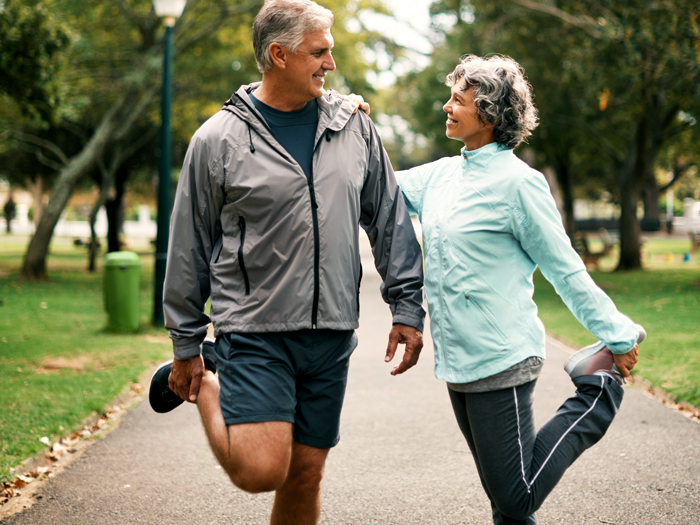Is Running Safe for Older Adults?
A running routine can be hugely beneficial at any age—as long as you follow these tips.

If you’ve ever thought you’re too old to start—or continue—running, allow us to introduce you to Ed Whitlock. The Canadian running champion broke countless world records well into his retirement years, becoming the oldest person to complete a marathon in less than four hours in 2016. He was 85.
Whitlock lived to see 86, and it’s very possible his commitment to running played a role in his longevity.
A 21-year study in JAMA Internal Medicine found longtime runners were less likely to deal with disability later in life and more likely to live longer. That’s because running can help improve heart health, strengthen bones, reduce inflammation, and keep your mind sharp, the researchers say.
But you don’t have to commit to a marathon or even a 5K to enjoy all the perks of running or jogging.
“I strongly believe that there are huge benefits to any activity continued as we age,” says Nate Helming, an endurance coach and co-founder of The Run Experience in San Francisco. “Running is one of the best, if not the best, exercises from a cardiovascular standpoint.”
Plus, it taps into your inner kid. “There’s something about it that’s enjoyable and fundamental to who we are,” Helming adds.
How to Start, Continue, or Resume Running Safely
As always, talk to your doctor before you start any new activity, especially a high-impact exercise like running. If you already run but have had a change in your health or experienced any injuries, talk to your doctor about your current fitness—and any steps you should take to get moving again safely.
“The biggest risk is an overuse injury,” Helming says. That includes things like:
- Runner’s knee, or pain in the front of the knee caused by the kneecap rubbing against the thighbone
- Achilles tendon pain, or pain in the tendon that connects your calf muscle to your heel bone
- Shin splits, or pain in the front of your lower leg due to inflammation
- Stress fractures, or small breaks in the bone
“A lot of that has to do with your body giving you feedback,” Helming says. That’s why it’s so important to think ahead—think prevention.”
If your doctor gives you the green light, begin with short runs at a moderate pace, and follow these steps to minimize your risk of injury.
Step #1: Take Short Breaks to Reset Your Running Form
“Break up your running into smaller, digestible pieces,” Helming suggests. For example, you could run for three minutes, walk for one minute, and continue alternating for a total of 20 to 25 minutes.
Another option: Sneak in some bodyweight exercises. Run for three minutes, stop, do five squats, and then run again for three minutes. The next time you stop, try an upper-body exercise like pushups or shoulder squeezes.
“Every time you take a break, start again with a little bit better posture, your breathing is more under control, and your running mechanics are a little bit better,” Helming explains. “All of those things are crucial if you want to stay focused and injury-free.”
Step #2: Don’t Let Running Be Your Only Form of Exercise
If you run one or two days per week, add at least one more day of strength or cross training, Helming says.
You could do a workout at the gym, like this 30-minute total-body strength plan; take your favorite group fitness class; or do bodyweight exercises at home, like these four exercises older adults should do every day.
“Research suggests building and maintaining strong muscles, especially in the muscle groups surrounding your hips, may help you avoid overuse injuries,” Helming says.
Subscribe to our newsletter
It's quick and easy. You could be one of the 13 million people who are eligible.
Already a member? Click to discover our 15,000+ participating locations.
Follow Us
Want to give your hips extra attention? Add two or three of these exercises that strengthen your hips to your weekly routine. They’re designed to work your hips in their full range of motion to help you stay strong and injury-free during other activities—running included.
Step #3: Recover Properly After Every Run
Stretching after your run can make a huge difference in how your body recovers, Helming says. These five stretches are great after a walk, jog, or run.
“Within the first five minutes after your run, do a cooldown,” Helming says. “One of my favorite things to do is to sit into the bottom of my squat and hold that for two minutes. It opens up your hips and stretches out your calves and ankles a bit.”
Give it a try: Sit into a squat, and hold as long as you can. If it’s only 10 or 15 seconds to start, that’s fine. As you get stronger, you’ll be able to hold the position longer.
You might feel a little discomfort if your muscles are tight—that’s normal. If you feel any sharp pains, ease up. Ultimately, stretching will help improve range of motion in your hips, knees, and ankles—helping you move stronger and faster during your next run.
Take Your Favorite SilverSneakers Classes Online!
SilverSneakers members can access live fitness classes and wellness workshops through SilverSneakers LIVE. See the latest schedule and RSVP for classes here.
Not a member? If you have a Medicare Plan, it may include SilverSneakers—at no additional cost. Check your eligibility instantly here.




